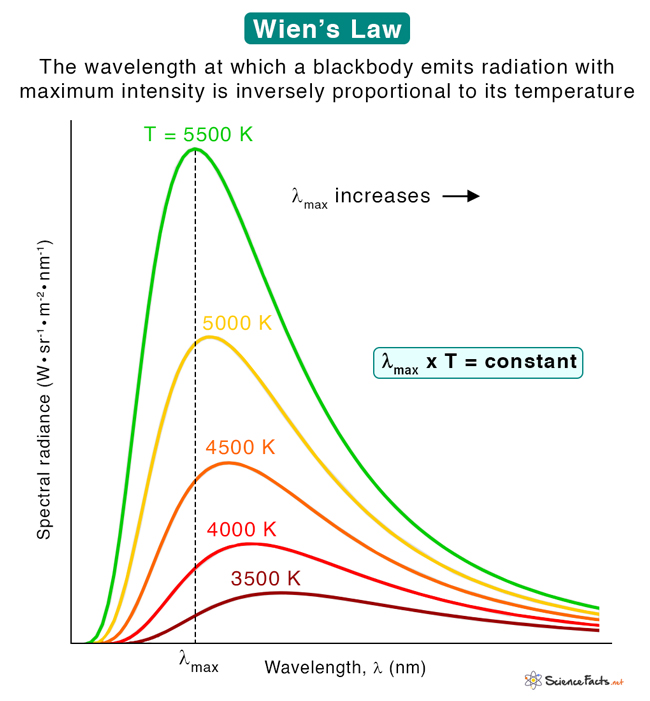Wien’s Law
Wien’s law, also known as Wien’s displacement law, gives a relationship between the wavelength of thermal radiation and the temperature at which a blackbody emits the radiation. According to this law, the temperature is inversely proportional to the wavelength at which the radiation has maximum intensity.
This law is named after German physicist Wilhelm Wien who derived it in 1893.
Formula
Wien found that the radiative energy per second per wavelength interval
Where
λmax: Wavelength at which the radiation intensity is maximum, known as peak wavelength
b: A constant called Wien’s constant, whose value is 2.897 x 10-3 m·K
T: Absolute temperature
The above equation can be written in a more generalized form.
λmax x T = 2.897 x 10-3 m·K
The radiation at peak wavelength that a blackbody emits makes it simple to estimate the approximate temperature of hot bodies. As this is an inverse relationship, the higher the temperature, the shorter the wavelength. It implies that hot objects emit radiation in the violet or ultraviolet end of the visible spectrum. On the other hand, the lower the temperature, the longer the wavelength. It means that cold objects emit radiation in the red or infrared end of the visible spectrum. This is why hotter objects appear blue and colder objects appear red.
Wien’s Law Graph
The shift in the peak wavelength can be traced through a set of intensity vs. wavelength curves at different temperatures, as shown in the image below. These curves are known as Planck curves. Each curve passes through a maximum corresponding to the peak wavelength. The different values of λmax and T satisfy Wien’s law equation.
Applications
- To study blackbody curves and determine the temperatures of stars, including the Sun
- To make LED light bulbs with different colors and temperatures – Warm white is between 2700 and 3200 K. Natural white is between 4000 and 4500 K. Cool white is between 7000 and 7500 K.
Solved Problems
Problem 1. The average surface temperature of the Sun is approximately 5778 K. What wavelength in nanometers is the peak intensity of the light coming from the Sun? What part of the visible spectrum does this wavelength correspond to?
Solution
Given T = 5778 K
Wien’s law equation is
λmax x T = 2.897 x 10-3 m·K
Therefore, the peak wavelength is
λmax = 2.897 x 10-3 m·K/T
=> λmax = 2.897 x 10-3 m·K/5778 K
=> λmax = 5.01 x 10-7 K or 501 nm
Therefore, the wavelength of light emitted by the Sun corresponds to the greenish-yellow band of the visible spectrum.
Problem 2. Determine the surface temperature of a star with a peak wavelength of 950 nm.
Solution
Given λmax = 950 nm
Wien’s law equation is
λmax x T = 2.897 x 10-3 m·K
Therefore, the surface temperature of the star is
T = 2.897 x 10-3 m·K/ λmax
=> T = 2.897 x 10-3 m·K/ 950 x 10-9 nm
=> T = 3049 K
-
References
Article was last reviewed on Wednesday, February 1, 2023









SOLVE MORE PROBLEM BY APPLYING WEINS LAW
We have posted two solved problems. We think those problems are adequate for our visitors to grab the concept of Wien’s Law.